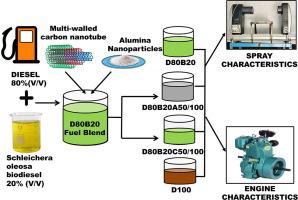Sustainable Energy Technologies and Assessments ( IF 7.1 ) Pub Date : 2020-10-08 , DOI: 10.1016/j.seta.2020.100833 Mukul Tomar , Naveen Kumar

|
In the present research, the efforts have been lodged to improve the combustion and performance characteristics along with exhaust emissions of diesel-schleichera oleosa biodiesel blends by adding nanoparticles of alumina and multi-walled carbon nanotubes. The nanoparticles (np’s) were synthesized and their morphologies were characterized by using Field-Emission Scanning Electron Microscopy (FESEM) and X-ray Diffraction spectroscopy (XRD) techniques. Test fuels containing 50 ppm and 100 ppm dosage of nanoparticles were dispersed with diesel–biodiesel blends and were labelled as D80B20A50, D80B20A100 (alumina (Al2O3) nanoparticles) and D80B20C50, D80B20C100 (multi-walled carbon nanotubes (MWCNT)). The droplet size of test fuels was analysed by using a laser-diffraction based Malvern Spraytec set-up. Interestingly, nano-additive dispersed test fuels showed smaller droplet size due to the higher force of collision between the nanoparticles. Moreover, the engine trial showed up to a 2–13% increase in brake thermal efficiency and upto 5–60% drop in exhaust emissions for nanoparticles dispersed test fuels. Also, alumina showed better results than MWCNT in terms of higher thermal efficiency, lower specific energy consumption and lower exhaust emissions as compared to diesel. However, due to the superior sorbent of nitrogen oxides, the (100 ppm) MWCNT has resulted in a maximum reduction of NO emissions.
中文翻译:

多壁碳纳米管和氧化铝纳米添加剂在油菜schleichera oleosa生物柴油混合物供油的轻型柴油发动机中的作用
在目前的研究中,人们通过添加氧化铝和多壁碳纳米管的纳米颗粒,努力改善柴油-schleichera oleosa生物柴油混合物的燃烧性能和排气排放。合成了纳米颗粒(np),并使用场发射扫描电子显微镜(FESEM)和X射线衍射光谱(XRD)技术表征了它们的形貌。将含有50 ppm和100 ppm纳米粒子剂量的测试燃料与柴油-生物柴油混合物一起分散,并标记为D80B20A50,D80B20A100(氧化铝(Al 2 O 3)纳米粒子)和D80B20C50,D80B20C100(多壁碳纳米管(MWCNT))。通过使用基于激光衍射的Malvern Spraytec装置分析测试燃料的液滴尺寸。有趣的是,由于纳米颗粒之间较高的碰撞力,纳米添加剂分散的测试燃料显示出较小的液滴尺寸。此外,该发动机试验还显示,对于分散有纳米颗粒的测试燃料,制动器的热效率提高了2-13%,废气排放降低了5-60%。同样,与柴油相比,氧化铝在热效率,更低的比能耗和更低的废气排放方面表现出比MWCNT更好的结果。但是,由于氮氧化物的优异吸附剂,(100 ppm)MWCNT已导致最大程度地减少NO排放。











































 京公网安备 11010802027423号
京公网安备 11010802027423号